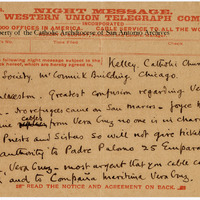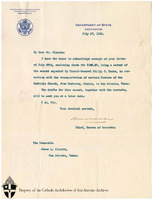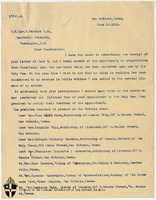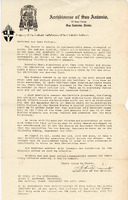Introduction to the Project:
Opening paragraph to introduce the project (in progress)
Finding Aid created in partnership with the Archdiocese of San Antonio
Historical Background of the Mexican Revolution and Cristero War
The Mexican Revolution was a period of civil and political strife in Mexico. It began with the conflict between Francisco I. Madero and President Porfirio Díaz, which resulted in the resignation and exile of Díaz. Madero was elected but faced an armed revolt in Morelos led by Emiliano Zapata. After Madero's resignation and assassination, various factions rose in opposition to the government led by President Victoriano Huerta. The revolutionary factions eventually defeated the federal armies but turned on each other. Venustiano Carranza led the Constitutionalist army and enacted the Mexican Constitution of 1917. Carranza was later killed during a revolt by former revolutionary generals. This was followed by a period of violent conflicts that occurred in Mexico from 1920 to 1930, with infighting among revolutionary generals and the enforcement of anticlerical policies leading to the Cristero War from 1926 to 1929.
Refugees in the Early Period (1910-1920)
In 1914, amid the conflict between federal and revolutionary forces, many Catholics sought refuge in the United States. The refugees consisted of members of the Catholic clergy and numerous laity. Under the direction of Bishop Shaw, the then Diocese of San Antonio began efforts to accommodate these refugees. With the aid of the Catholic Extension Society, Shaw was able to house several members of the Mexican Catholic Church clergy in San Antonio, and many nuns and members of other religious orders found refuge with their American counterparts. Utilizing the Mexican Refugees Relief Fund, which was a collection of funds donated from various groups, money collected by the Diocese, and money sent by the Catholic Extension Society, Bishop Shaw was able to support the clergy and many laity in need.
As part of their support for the exiles, the Diocese welcomed key figures of the Mexican Catholic Church such as Most Rev. Jose Mora, Archbishop of Mexico, Most Rev. Leopoldo Ruiz, Archbishop of Michoacan, and Most Rev. Francisco Plancarte y Navarrete, Archbishop of Linares. Additionally, with the support of the Sisters of Divine Providence, a seminary school was established in Castroville. The St. Philip of Neri Seminary operated for several years under the direction of the exiled Rt. Rev. Juan Herrera, Bishop of Tulancingo. There is also evidence that the 63rd Congress of the United States and the US State Department were involved in the relocation of refugees from Mexico to the Diocese at the request of Honorable James L. Slayden of San Antonio, Texas.
Bishop Shaw established the Mexican Relief Fund to assist the exiled clergy and laity. This fund offered direct financial assistance to individuals, gathering and allocating funds as necessary to support the needs of the exiles. In partnership with the Catholic Extension Society President Francis C. Kelley and the U.S. Department of State, Bishop Shaw was able to aid in relocating refugee nuns and priests to San Antonio and Cuba from Vera Cruz.
Refugees in the Late Period (1920-1930)
As the situation in Mexico began to improve, the clergy and laity returned. However, with the outbreak of the conflicts of 1920-1930, the clergy again had to flee. Unlike before, much of the laity began to take up arms to defend themselves against the persecution they now faced. This change in spirit within the laity led to the Cristero War where Catholics across Mexico fought against the widespread anticlerical policies in the Mexican Constitution of 1917.
During Archbishop Drossaerts' tenure, the Archdiocese of San Antonio opened its doors to refugees fleeing the new conflict. Many clergy who had previously sought refuge in San Antonio after being exiled by the Calles government became more active during this period. Most Rev. Jose Mora, Archbishop of Mexico, and Rt. Rev Ignacio Valdespino, Bishop of Aguascalientes, emerged as prominent figures, advocating for Catholics and Catholic social action movements. This time marked a significant shift in Mexico's treatment of these exiles, as violence towards exiled Catholics, including assassinations and kidnappings, escalated. The Apostolic Delegate in Mexico was also forcibly expelled from the country.
Archbishop Drossaerts collaborated with the Catholic Extension Society to provide housing and, in some cases, assist with the relocation of the refugee clergy. By maintaining regular communication with the Apostolic delegate, Archbishop Drossaerts successfully coordinated with Catholic leaders across the country, garnering support to aid the exiles fleeing the Cristero War.





